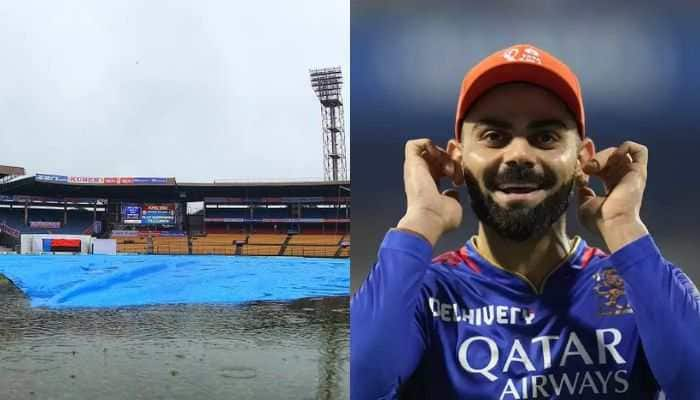WATCH LIVE: Gaganyaan Flight Test Vehicle Abort Mission Launched Successfully After Fixing Glitch
Defining the mission, ISRO said, "In-flight Abort Demonstration of Crew Escape System (CES) at Mach number 1.2 with the newly developed Test Vehicle followed by Crew Module separation & safe recovery."
Trending Photos
)
The Indian Space Research Organisation (ISRO) today successfully launched the Flight Test Vehicle Abort Mission at 10 am after putting it on hold earlier this morning due to technical glitch. The crew module successfully detached from the launch rocket and landed safely using parachutes in the Bay of Bengal. The crew module landed 10km distance from the launch site, marking another feat for ISRO. The Indian Navy will recover the module and bring it back to the space agency. It took 8 minutes for the crew module to land at sea in the Bay of Bengal.
Addressing the media after the successful launch, ISRO Chairman S Somnath said that the launch was rescheduled at 8.30 am from 8 am due to weather issue and was later put on hold due to technical issue by the ground computer. "We initially wanted the launch to happen at 8am. But there was some weather related issues. We rescheduled the launch at 8.45am. But after going through the nominal lift-off process, there was a hold issued by the ground computer which is called the automatic launch sequence computer which detected a non-confirmance for allowing the engine to continue the thursting to go up. This was due to a monitoring anomaly system. We identified it very fast and corrected," said Somnath.
#WATCH | Gaganyaan Mission: After the successful touch down of the crew escape module, ISRO chief S Somanath congratulates scientists pic.twitter.com/YQp6FZWXec — ANI (@ANI) October 21, 2023
"I am very happy to announce the successful accomplishment of the TV-D1 mission. The purpose of this mission was to demonstrate the crew escape system for the Gaganyaan program through a test vehicle demonstration in which the vehicle went up to a Mach number, which is slightly above the speed of sound and initiated an abort condition for the crew escape system to function. The crew escape system took the crew module away from the vehicle and subsequent operations including the touch-down at the sea have been very well accomplished," said Somnath annoucing the successful launch.
The ISRO chief further said that the time between 8.45 and 10 am was used for not only correcting the glitch but also for refilling gases. ISRO today informed that it has identified and corrected the reason for the launch hold.
"Kudos ISRO for successfully accomplishing maiden Test Vehicle Flight TV-D1. This is the first step in the last leg of journey towards India’s Crewed Human Spacecraft mission Gaganyaan. In the enabling milieu provided by PM Narendra Modi, ISRO achieving one success after the other," said Union Minister of State Science & Technology Dr Jitendra Singh.
Gaganyaan Abort Mission Video Here
#WATCH | Sriharikota: ISRO launches test flight for Gaganyaan mission after first test flight was aborted pic.twitter.com/pIbmjyJj3W — ANI (@ANI) October 21, 2023
After the mission was put on hold, Somnath said, "The lift-off attempt could not happen today...engine ignition has not happened in the nominal course, we need to find out what went wrong. The vehicle is safe, we need to look at what happened...we will come back soon...the computer which is doing function has withheld the launch...we will correct it and schedule launch soon."
#WATCH | Gaganyaan’s First Flight Test Vehicle Abort Mission-1 (TV-D1) launch on hold
ISRO chief S Somnath says, The lift-off attempt could not happen today...engine ignition has not happened in the nominal course, we need to find out what went wrong. The vehicle is safe, we… pic.twitter.com/wIosu113oT — ANI (@ANI) October 21, 2023
Mission Definition
Defining the mission, ISRO said, "In-flight Abort Demonstration of Crew Escape System (CES) at Mach number 1.2 with the newly developed Test Vehicle followed by Crew Module separation & safe recovery."
Mission Objective
Defining the mission object, ISRO said that three key things will be achieved with this test. The objectives are - Flight demonstration and evaluation of Test Vehicle sub-systems, Flight demonstration and evaluation of Crew Escape System including various separation systems and Crew Module characteristics & deceleration systems demonstration at higher altitude & recovery.
Abort Scenario Testing
The test flight is designed to replicate an abort scenario that occurs during the ascent phase. At an altitude of approximately 17 kilometres, the crew escape systems, including crude modules, will be detached from the test vehicle. Following this, the autonomous abort sequence will initiate, starting with the separation of the crew escape systems and the deployment of a series of parachutes. Ultimately, the crew module will touch down safely in the sea, approximately 10 kilometres off the coast of Sriharikota.
Prime Minister Narendra Modi has earlier chaired a high-level meeting to assess the progress of India's Gaganyaan mission and to outline the future of India's space exploration programs, the PMO said. It was noted that around 20 major tests, including 3 uncrewed missions of the Human Rated Launch Vehicle (HLVM3) are planned. The first demonstration flight of the Crew Escape System Test Vehicle is scheduled today. The prime minister's review meeting evaluated the mission's readiness, affirming its launch in 2025.
The Gaganyaan mission comes after ISRO's back-to-back success of Chandrayaan-3 and Aditya L1 sun mission.
Live Tv







)
)
)
)
)
)
)
)
)
)
